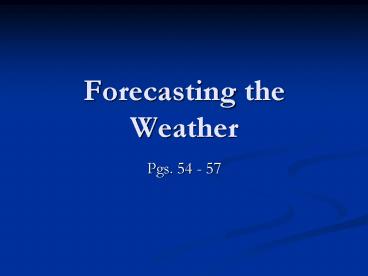Forecasting the Weather - PowerPoint PPT Presentation
1 / 16
Title:
Forecasting the Weather
Description:
Forecasting the Weather Pgs. 54 - 57 What s it like outside? At some point you have probably gone outside wearing clothes that did not prepare you properly. – PowerPoint PPT presentation
Number of Views:322
Avg rating:3.0/5.0
Title: Forecasting the Weather
1
Forecasting the Weather
- Pgs. 54 - 57
2
Whats it like outside?
- At some point you have probably gone outside
wearing clothes that did not prepare you
properly. - Weather affects what you wear and possibly the
places you go. - A weather forecast is a prediction of weather
conditions over the next 3 to 5 days. - Meteorologists predict the weather after
observing and collecting data on current weather
conditions.
3
Weather Forecasting Technology
- To predict the weather, we need to measure air
pressure, humidity, precipitation, temperature,
wind speed and wind direction. - To measure these atmospheric conditions we need
to use special equipment. - For humidity, we use a psychrometer and for
precipitation we use a rain gauge.
4
Measuring Air Temperature
- To measure air temperature we use a thermometer.
- A standard thermometer uses a liquid sealed in a
narrow glass tube. - When the temperature increases or decreases so
does the liquid in the tube. - Temperature can be measured in degrees Celsius or
Fahrenheit.
5
Measuring Air Pressure
- A barometer is an instrument used to measure air
pressure. - An accurate type of barometer is a mercurial
barometer that uses a glass tube sealed at one
end. - Mercury is the liquid used.
- Air pressure moves the liquid
- as pressure changes.
6
Measuring Wind Direction
- Wind direction can be measured using a windsock
or wind vane. - A windsock is a cone-shaped bag open at both
ends. - The wide end is open to the direction the wind is
coming from. - A wind vane is a shaped like an arrow with a
large tail and is attached to a pole. - The arrow points into the wind.
7
Measuring Wind Speed
- Wind speed is measured by an anemometer.
- It consists of three or four cups connected by
spokes to a pole. - The wind pushes on the hollow sides of the cups,
causing them to rotate on the pole. - The motion causes an electrical current that is
measured and displays a speed.
8
Measuring Weather in the Upper Atmosphere
- In order to study the weather in the upper
atmosphere, you need to collect data from higher
altitudes. - To do this you can use a weather balloon, radar
or satellites. - Weather balloons carry equipment and measure up
to 30 km above the Earth.
9
Radar and Weather Satellites
- Radar is used to find the location, movement, and
intensity of precipitation. - The type of precipitation can also be detected.
- Weather satellites are orbiting the Earth and can
provide the images of swirling clouds you can see
on television weather reports. - They measure wind speed, humidity and temperature
at different altitudes.
10
Weather Maps
- In the U.S., there are two major sources used to
collect and analyze weather data National
Weather Service (NWS) and the National Oceanic
and Atmospheric Administration (NOAA). - They produce weather maps based on information
from over 1000 weather stations. - On the maps, each station is represented with a
station model with symbols describing its data.
11
(No Transcript)
12
Pressure
- Weather maps include lines called isobars.
- These are lines that connect areas of equal
pressure. - Areas they encircle are marked on maps as either
High or Low Pressure.
13
(No Transcript)
14
(No Transcript)
15
(No Transcript)
16
(No Transcript)































